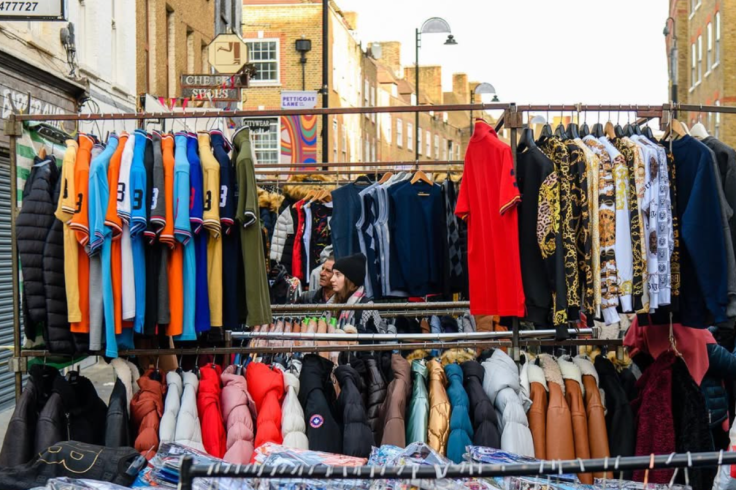£1 Deals: The Budget-Friendly London Street Market Dating Back To The 17th Century
Petticoat Lane Market is one of London's oldest and cheapest markets, with a multi-cultural heritage.

Nestled amongst a slew of gentrified markets on London's east side lies Petticoat Lane Market.
Rich in both history and culture, the authentic Sunday market is also famous for its exceptional deals on discounted designer apparel items and diverse range of goods.
Petticoat Lane Market can be found right in the middle of Tower Hamlets and the City of London. It operates two markets, a food market during weekdays on Wentworth Street, and it's iconic Sunday clothing market runs from 9:00am–3:00pm on Middlesex Street.
With root's dating back as early as 1608, and with low-budget approved deals, this market is one worth checking out next time you're in East London.
A History Dating Back To Tudor Times
That's right. Petticoat Lane Market's history dates all the way back to the 17th century. Back in Tudor times, the market was known as Hog's Lane as it initially sold rural goods and livestock. As the area became more populated and cottages lined the streets, the name was changed to Petticoat Lane in the early 1600s.
The market's name potentially comes from a tale claiming women's petticoats would be stolen from you at one end of the market and sold back to you at the other.
If you go looking for Petticoat Lane today, you won't find it. During the Victorian era, the name was considered too racy due to its connection with women's undergarments. The street name was officially changed to Middlesex Street. However, the market is still widely regarded as Petticoat Lane Market today.
Market's Rich Culture Comes From Centuries Of Immigration
The market's success and continuation can be credited to waves of immigration to London's east side.
Huguenots, the French Protestants, arrived in the 17th century, many of whom were weavers. This increased the markets sales in textiles and by the mid-18th century, Petticoat Lane Market had established itself as the place to go for second-hand goods and the manufacturing of clothes.
The Sunday market's popularity increased greatly in the 18th century when large groups of Jewish traders arrived in the area. Its endurance throughout the centuries is often credited to the Jewish community, who wanted to shop on Sunday's since their Sabbath is on Saturday's.
In the 20th century, the market's reputation plummeted. It became known for attracting criminals and suspicious activity. The police would regularly conduct raids and it wasn't unusual for them to drive their cars through the market to disrupt it's happenings.
However, a new wave of immigration from India, Bangladesh, and South East Asia in the 1970's helped the market prosper again and form the cultural shopping hub that it is today.
Your Proper East End Market
London-based agency The Workroom was approached in 2018 to give the market a rebranding as part of regeneration efforts for the surrounding area. The Workroom came up with a bespoke new typeface that reflected the market's multi-cultural heritage.
On their website, The Workroom explained how they wanted the rebrand to express the authenticity of Petticoat Lane Market.
'Our challenge was to create a new brand to help rebuild the profile of the market but one that did not fall into the trap of many of the newly 'gentrified' markets that had out-priced and excluded both locals and traditional traders.'
With this in mind, The Workroom used the line 'Your Proper East End Market' to position the new brand.
Petticoat Lane Market Today
In the 21st century, Petticoat Lane Market bustles with shoppers from all types of cultural and economic backgrounds. Its Sunday Market alone has over 1000 stalls, with unbelievable deals on clothes ranging from vintage to the latest trends, but also textiles and fabrics including West African prints.
Tourists, students, and locals alike weave their way through throngs of shoppers at a leisurely pace, stopping to paw through colourful racks and heaping tables. You'll be sure to spot vendors negotiating with the more experienced bargain-hunters, or helping shoppers find the perfect item. The atmosphere remains friendly and relaxed, despite how busy the market can be.
Petticoat Lane Market's accessibility to other parts of the city helps bring in its foot traffic. The closest tube stations are Aldgate (Metropolitan, Circle); Aldgate East (Hammersmith & City, District); Liverpool Street (Central, Circle, Hammersmith & City, Metropolitan, Overground, TFL Rail).
As one of London's oldest markets, Petticoat Lane Market brims with culture and history. Along with its accessibility and guarantee of finding a bargain on a range of goods, there's no reason not to visit this historic market.
© Copyright IBTimes 2025. All rights reserved.





















